The new FABnyc sidewalk mural, fashioned by Ecuadorian artist Raúl Ayala, is among our favorite public artworks to surface this year. On one of our many visits to Extra Place in Manhattan’s East Village, we had the opportunity to speak to the amazing artist.
When did you start creating art?
When I was a child, I had difficulty sleeping at night. My mind was plagued by hallucinations, and I would panic. My parents didn’t know what to do with me. Then we learned that what I was experiencing is known as hypnagogic hallucinations, a kind of somnambulism. A doctor told my parents that in earlier times, this condition was considered a gift. So to fight the fear of night, I began to draw.
And what happened to the hallucinations and panic attacks?
They stopped.
Wow! Did you go on to study art in a formal setting?
Yes. I studied Visual Arts at the university back home in Ecuador. I graduated in 2007.
Was your education helpful?
These days my art reflects mostly what I learned after I graduated, but the formal education that I received gave me the opportunity to teach, and I love teaching.
What inspired you to get up on public spaces?
While teaching inmates in Ecuador’s prison system, I came up with the idea of using the prison walls as a canvas. I see walls as the ideal canvas – as they are a metaphor for separation – all kinds of separations…social, economic, physical.
What about graffiti? When did you start doing graffiti?
I went to Argentina for one year to study painting. There the walls are filled with graffiti. When I returned to Ecuador, I began doing graffiti with a spray can. I always preferred the brush, though, and I consider myself a muralist more than a graffiti artist.
What is the attitude of your parents towards your life as an artist?
At the beginning it was difficult for them. But now, they see me happy and productive, and they’re great about it.
What percentage of your time is devoted to art?
Just about all of it. During the day, I work as an art handler for a Chelsea gallery to pay my bills. Other times, I do my own art.
Do you prefer working alone or collaborating with others?
I like to work alone, but I also love working with others. I have collaborated with D*Face and Liqen, along with many other friends and partners in crime. I love the challenge of collaboration, and I think it’s the best learning experience an artist can have!
Do you work with a sketch, or do you let it flow?
I always have lots of sketches, but I’m not faithful to them.
Are you generally satisfied with your finished work?
No.
How do you feel about the movement of graffiti and street art into galleries?
Once art goes into a gallery, it becomes merchandise. It’s all about money. The power of graffiti is its relationship with the city and the people. I see graffiti as a means to communicate with others and as social commentary.
Have you exhibited your work at in any gallery spaces, and how did you feel about it?
My first solo exhibit was at Arteactual FLACSO back home in Ecuador. I did it with the understanding that I could paint all the walls in the gallery. And then we sold prints. I feel that we artists have to take advantage of all the spaces available to us, and if we are going to use a gallery, we have to find a way to question that private space. I prefer outdoor walls, because my mission as an artist is to visually and intellectually engage a broad community of people.
Are there any particular cultures that influence your aesthetic?
Yes. Pre-Columbian and other Ecuadorian nationalities and cultures like the Shuar and Waorani from the Amazon Jungle, and Valdivia and Chachi from the coast.
Any favorite artists or influences?
I have lots of influences — many that do not come from visual arts. These days I am obsessed with the writer Roberto Bolaño, and I am also reading about the Reconstruction Era here in the USA. Among the younger visual artists I like are: Liqen, Hyuro, Escif and Vazco Basko. The more mature ones include: Dennis McNett and Miguel Varea. Some of the dead ones are: Guadalupe Posadas, Guaman Poma, Francis Bacon, el Bosco and los Muralistas Mexicanos. Tattoos and Brazilian Pixacao are other movements that I observe. In terms of music, I am more of a death metal head but I am, also, into Latin American music, specially old tunes.
What brought you to New York City?
I was living with my girlfriend in Ecuador, and she needed to move back to the U.S. to get her citizenship. We tried the long-distance relationship thing, but that didn’t work so well. So I decided to move here. We are now staying in New York City, and I am experiencing first-hand what it’s like to live and work as an immigrant. And we recently got married!
What is your impression of New York City?
I have only been here for a year and a half, so I am still pretty new in the city, Although I have found friends and support, I feel it’s a hard city. I see it as a rich playground, with the rich players blind to the workers behind the scene.
How does the street art/graffiti here in NYC differ from that back home in Ecuador?
The graffiti writers in Quito are very experimental. Also, one almost never gets arrested back home. There is a bit of a stigma to the use of the spray can, and so a police officer may stop you if you are using one. But graffiti is not regarded as a criminal act! You know that you can talk to the police, and they may leave you alone. You still need to be very careful and fast, but there is more freedom to paint in the streets in Ecuador than here in NYC.
Tell us something about your current project.
I’m working here at Extra Place with James Rubio from the Antagonist Art Movement on a FABnyc sidewalk mural. Inspired by a poem Dee Dee Ramone wrote about Joey soon after his death, it features wild creatures, representing punk rockers, carrying a dragon cloud — a symbol of Joey’s spirit. This mural is a tribute to Arturo Vega. It could have never happened without his influence and support.
What’s ahead?
I am a Fellow for the Create Change Professional Development Program at the Laundromat Project. I’m learning how to work with socially-engaged art here in NYC. I’m quite excited about this. I am looking forward to producing artwork in my current neighborhood in Bed-Stuy, Brooklyn. I will keep you posted! Also, I am participating in the exhibit For Which It Stands at The Lodge Gallery at 131 Chrystie Street on Manhattan’s Lower East Side. Curated by Keith Schweitzer and Jason Patrick Voegele, it opens tomorrow evening — Friday, June 28, 6-9pm and continues through July 28.
It sounds great! Good luck!
Photos by Tara Murray and Lois Stavsky
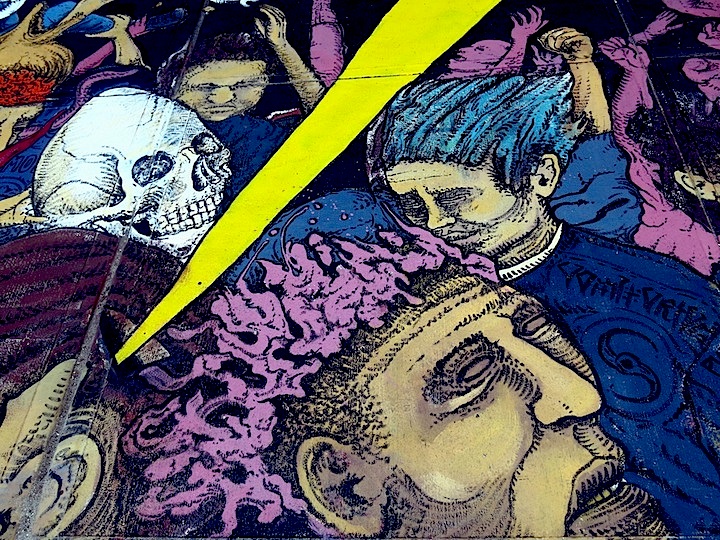
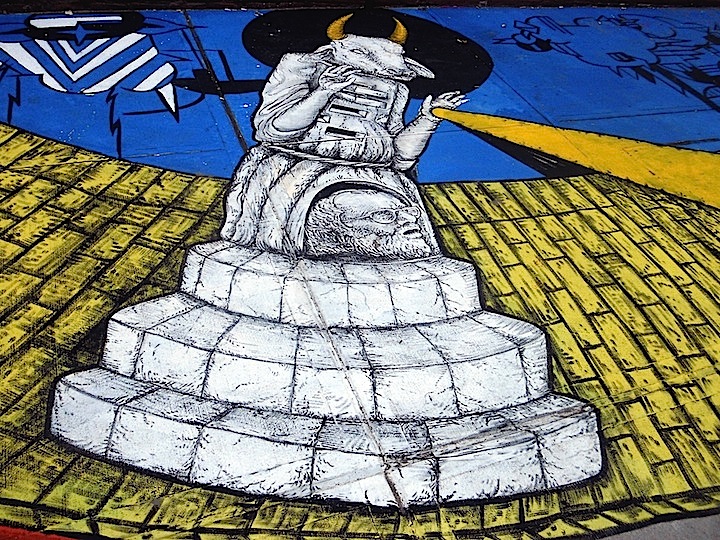
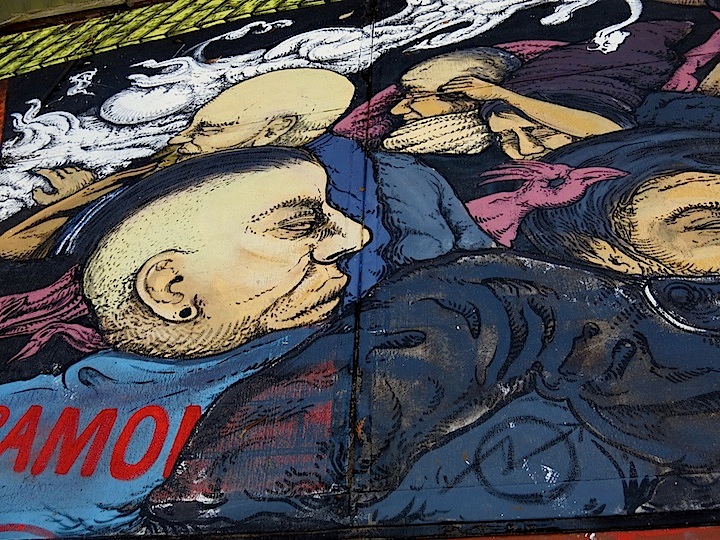
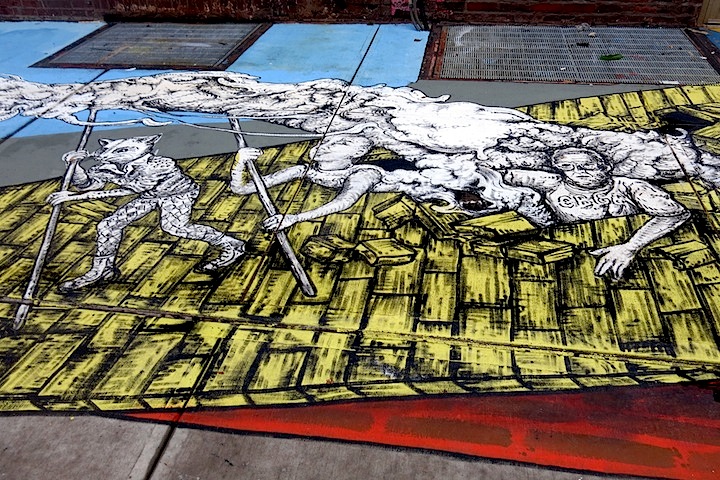
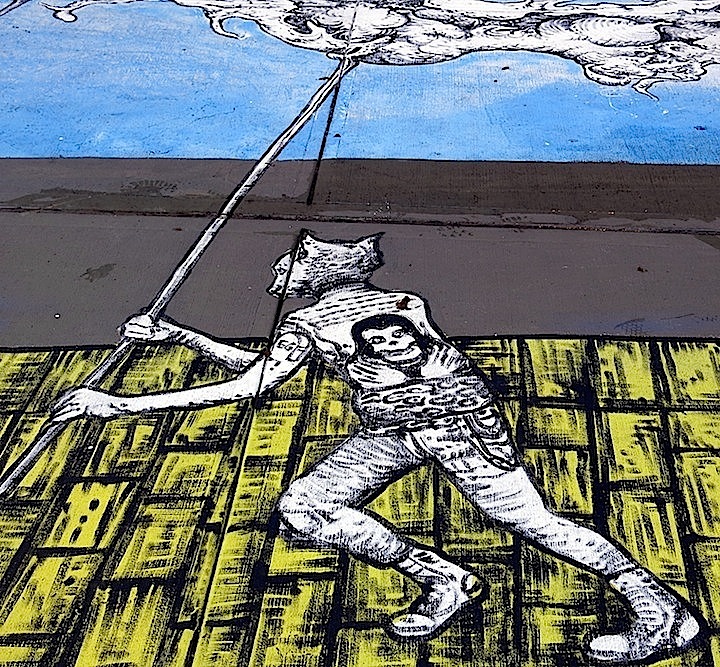

{ 2 comments… read them below or add one }
Dear Raul, Such a long time since you were here in LA staying with us ! I often regret not taking sketching things for our outing at the LA Zoo ! You surely have progressed in your profession and we are proud to know you and follow your career. Congratulations on your marriage and your up and coming career in art!
Yours fondly, Marcia
Esa es Rul representing!
{ 1 trackback }